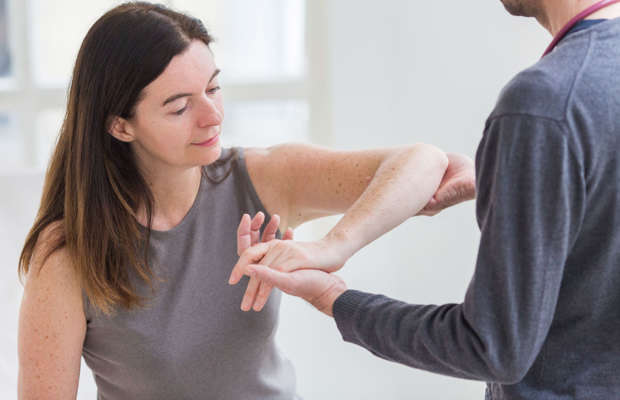4 Exercises Joint Specialists Would Never Do
© Burger/Phanie/Rex ShutterstockWhen it comes to working out, most of us want expert advice on what to do to get the best, quickest results while staying safe. Yet it can be just as important to ask the pros what exercises to steer clear of—especially if you want to avoid injuries. That's why we queried joint specialists around the country about what moves they avoid at all costs. Here are the exercises they say come with the biggest risk, and what to do instead.
Seated Hip Abduction/Adduction Machine
© Photograph by Microgen/ShutterstockAda Wells, DPT, PMA-CPT, physical therapist and rehabilitation expert says the main problem with doing abduction (outer thighs) and adduction (inner thighs) exercises on a stationary machine is that you're working the muscles in a non-functional position, which can ultimately compromise the pelvis and spine. "It's easy to load up the resistance and feel like you're doing a lot on this machine, but the problem is that you're starting in a position where there is no pre-activation of the core stabilizers to prepare the spine and pelvis for the load it's about to take on," she says.What to do instead: Standing Weight Shifting with a Pilates RingConsidering so many of our daily movements require shifting our weight from one side to the other, with walking being chief among those movements, strengthening the abductors and adductors is crucial. Place your feet inside a Pilates ring and bring your pelvis to neutral. While gently pressing outward with your shins against the ring, shift your weight from one foot to another. To make this exercise more difficult, bend your knees as if you were going to sit in a chair and continue to shift your weight from one foot to another, coming down into "chair" position and then standing up as you continue to shift your weight. Repeat 30 seconds to 1 minute, then rest. (You can use the Pilates ring to tone your arms, too.)
Seated Knee Extension Machine
© Photograph by Jasminko Ibrakovic/ShutterstockWhile this exercise does build quadriceps strength, it works the quads in isolation, which can be a recipe for knee pain, says Wells. "I never recommend seated knee extension moves because they can cause pain in the front of the knee, known as patellofemoral compression syndrome, due to the fact that there are no other muscle groups helping to take on the load you're lifting," she says. "The resulting quadricep contraction can create a lot of compression at the kneecap." (Try these 3 workouts for stronger, pain-free knees.)What to do instead: Step-UpsFind a step that's about an inch off the ground and, keeping your hips as level as possible, step your right foot up (allowing your left foot to lift off the ground) and then back down. Repeat on the right side 20-30 times, then repeat on the left. As you get good at doing this exercise with proper form, slowly work your way up to a 2-inch, and then 3-inch step. "This exercise is a great way to work the quadriceps while also keeping your knees safe," says Wells.
Neck Circles
© Photograph by Undrey/ShutterstockWith neck pain on the rise (thank you, sedentary desk jobs and our affinity for tiny mobile devices), Wells says she sees more people trying to ease that pain with old-fashioned head circles—and she's not a fan of the stretch. "For starters, the narrow space where the nerve roots exit the spinal canal is made even narrower when the neck is rolled back and to the side," she says. "This not only compromises the nerve but also compresses the spinal joints." What to do instead: Prone Upper Back ExtensionNeck pain often stems from not having enough mobility in the thoracic spine (the upper/mid back), says Wells, which is the area this exercise targets. Lie on your stomach with your forehead resting on your hands. Lengthen out through the top of your head as you slowly lift your head up; as you do that, gently press your ribs into the floor. (If you let the ribs come off the floor, you'll "dump" into the low back.) Repeat 5 to 10 times.
Pistol Squats
© Photograph by ShutterstockJacon Chun, MPT, a physical therapist with more than 20 years of experience, says these deep squats stress your standing leg with all of your body weight, which puts far too much pressure on the knee joint. "If you don't have the proper strength or muscle recruitment patterns, coming up from the bottom of these squats can increase your likelihood of injury," he says. (Learn how to do squats and lunges without killing your knees.)What to do instead: Step-Back LungesStart with your feet hip-width distance apart and hands on your hips. Keeping a slight bend in your knees, step back with your right leg until your left thigh is parallel to the floor. (As you do this, make sure your front knee is directly over your ankle.) Then, come back to the starting position and switch sides, alternating sides for 20 to 30 reps or until you're fatigued.
source : Prevention (http://www.prevention.com/)






1 Comments
Story of this blog is well written. The writer kept in consideration the grammar very well. Level of English also very well. Lot many new words has been used while writing content of this blog.zwangerschapsgym amsterdam
ReplyDelete